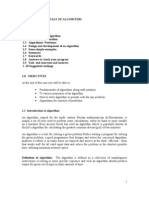0% found this document useful (0 votes)
13 views15 pagesIntroduction To Algorithms
This document outlines a lesson plan on algorithms, defining them as step-by-step procedures for problem-solving. It emphasizes the importance of clarity, order, and effectiveness in algorithms, providing examples and group activities for students to develop their own algorithms. Additionally, it includes questions and prompts to assess understanding of algorithm concepts and their application in everyday tasks.
Uploaded by
loisejrkeysCopyright
© © All Rights Reserved
We take content rights seriously. If you suspect this is your content, claim it here.
Available Formats
Download as PPTX, PDF, TXT or read online on Scribd
0% found this document useful (0 votes)
13 views15 pagesIntroduction To Algorithms
This document outlines a lesson plan on algorithms, defining them as step-by-step procedures for problem-solving. It emphasizes the importance of clarity, order, and effectiveness in algorithms, providing examples and group activities for students to develop their own algorithms. Additionally, it includes questions and prompts to assess understanding of algorithm concepts and their application in everyday tasks.
Uploaded by
loisejrkeysCopyright
© © All Rights Reserved
We take content rights seriously. If you suspect this is your content, claim it here.
Available Formats
Download as PPTX, PDF, TXT or read online on Scribd
/ 15
































































































